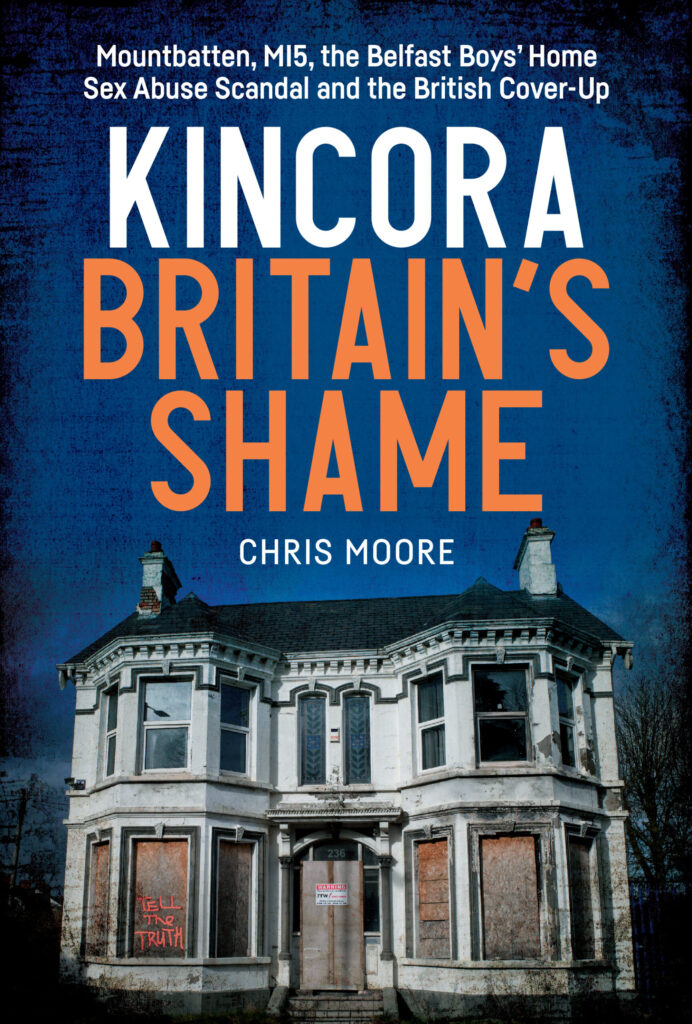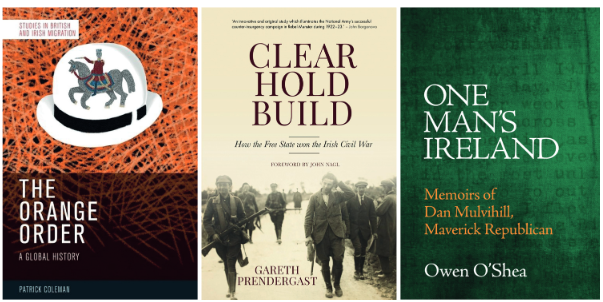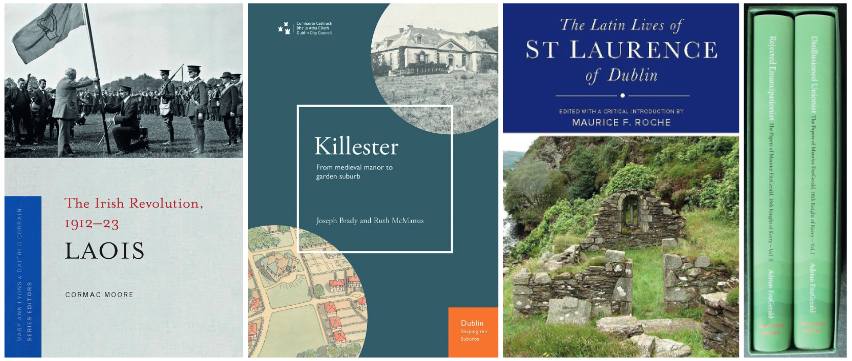By Daragh Fitzgerald
The odious vortex of sexual abuse, life-shattering trauma and collusion between loyalist paramilitaries, military intelligence and deviant predators at the top of the British establishment delineated in Chris Moore’s Kincora: Britain’s shame—Mountbatten, MI5, the Belfast Boys’ Home sex abuse scandal and the British cover-up brings the impact of Britain’s dirty war in the North into sharp relief, and represents an institutional and calculated subversion of justice that renders the British state’s current attempt to prosecute Mo Chara of Kneecap all the more risible. Moore has spent over 40 years researching this harrowing mire in the face of systemic silence and obfuscation. Opened in the 1950s as a refuge for vulnerable boys from difficult homes in Belfast, Kincora itself became a locus of abuse that provided victims for a countrywide ring of paedophiles, including Louis Mountbatten, who allegedly took his victims from Belfast and abused them at his castle in Mullaghmore in 1977. These horrors were overlooked and facilitated by the British state, which had an intelligence agent operating out of the boys’ home, linked closely with unionist politicians and loyalist paramilitaries. MI5 and the RUC blocked two investigations into Kincora in 1975, which allowed the abuse to continue for five more years until the home was finally closed in 1980. Justice was never served, however—in fact, whistle-blower Colin Wallace, a British Army intelligence officer, claims that he was framed and wrongfully convicted on a manslaughter charge for raising his concerns, while files pertinent to the scandal will remain sealed from the public until 2085.
July brings with it the unmistakable sound of fife and drum to streets across Northern Ireland—and, as outlined by Patrick Coleman in The Orange Order: a global history, to streets in places like Ghana and Togo too. The Orange Order was founded in 1795 with the explicit goal of upholding and defending Protestant Ascendancy, making it the oldest active political organisation in Ireland, and it quickly spread in Britain through regiments returning after brutally crushing the rebellion of 1798. The Order has since spread its wings across the British Empire via military deployments, from Derry’s walls to the Great Wall of China. Coleman presents a transnational history of the Order and acknowledges the ‘public relations’ problem that Orangemen (and women) face, as the perception of most outsiders is negative, and he thus discusses the charity work of the Order across the world as a counterweight. The Order, however, was born in the blood of slaughtered Catholics at the Battle of the Diamond, and over 200 years later it remains hard to see its apparent benevolence changing the opinions of residents of the Garvaghy Road at least.
Gareth Prendergast presents another counterweight to a dominant public narrative in Clear, hold, build—how the Free State won the Irish Civil War, as he analyses the National Army’s victory using counter-insurgency doctrine also utilised by US troops in Baghdad and Ramadi, which apparently reflects well on the Irish Free State. The text focuses on Munster, and on Cork city in particular; it explains how the Free State, facing an existential threat on the eve of the Civil War, was an adaptive learning organisation that drove the anti-Treatyites out using innovative amphibious landings, held the captured territory and routed out guerrillas, and then restored civil governance to the region. John Regan and others’ discussion of Collins’s dictatorial tendencies makes one wonder whether the last step could have been achieved without his death at Béal na Bláth, while the Free State’s policy of extra-judicial executions undermines any notion of legitimate and just civil governance in this period. Prendergast’s analysis is fresh and insightful but his focus on Cork allows him to skirt past the activities of Paddy O’Daly and the Dublin Guard in Kerry, which does indeed bear some resemblance to US soldiers’ actions in Iraq.
The brutal experience of the Civil War in Kerry features prominently in the memoir of Dan Mulvihill, which is published within a broader narrative of the period in Owen O’Shea’s One man’s Ireland: memoirs of Dan Mulvihill, maverick republican. Mulvihill described himself as a ‘maverick’ republican, and in fact was working in Marconi House in London transmitting air corps and marine communications while reading H.G. Wells’s The war of the worlds at the time of the Easter Rising. He subsequently joined the Volunteers in November of that year and spent much of his time with the West Cork IRA after winning a scholarship for an agricultural college in Clonakilty. Opposing the Treaty and helping to smuggle Dev out of Dublin after the battle of the Four Courts, Mulvihill was captured by a large contingent of National Army soldiers led by Paddy O’Daly on the same day as Collins’s death. He was imprisoned in the Great Southern Hotel in Killarney and was there the following month when David Neligan executed seventeen-year-old Bertie Murphy on the front porch in a reprisal for an anti-Treaty ambush.
Cormac Moore’s Laois: the Irish revolution, 1912–23 details the course of the revolution in what was then Queen’s County. Naturally enough, land was the big issue across the dark Central Plain, while the mines of the county provided explosives for the Volunteers during the Easter Rising and War of Independence. In fact, the first officially sanctioned shots of Easter Week were fired in Laois by the excellently named IRB man P.J. Ramsbottom, attempting to dissuade a railway worker from inspecting railway lines that had been blocked by the Volunteers.
Joseph Brady and Ruth McManus’s Killester: from medieval manor to garden suburb is more localised history though temporally broader, detailing the development of Killester since the Norman invasion. The area came under the influence of William Brun, a follower of Henry II, who granted him the land in the late twelfth century, laying the foundations for Killester’s development as a manorial estate, which was completed by the construction of Killester House in the early eighteenth century by Thomas Burgh. Like all of Ireland, Killester was changed utterly by the Great War, after which the British government chose the site for a garden suburb to provide homes for ex-servicemen.
The Latin Lives of St Laurence of Dublin presents the chief sources of our information on patron saint of Dublin Laurence O’Toole, one of the most distinguished Irish churchmen of the twelfth century. Born Lorcán Ua Thuathail to a Leinster petty king, he entered the monastery of Glendalough as a boy and was eventually consecrated archbishop of Dublin in 1162, a Gaelic prelate ruling over a Norse–Irish see. Things were about to get more complex, as Laurence witnessed the traumatic events of the Norman invasion and served as a link between the Gaelic political system and the new Angevin royal government, demonstrating how a prominent member of Gaelic society attempted to navigate the new political realities of the period.
Adrian FitzGerald collated and published the memoirs of his ancestor across two volumes in The papers of Maurice FitzGerald, 18th Knight of Kerry. Maurice was elected to parliament in 1795 and railed against its corruption; he welcomed the Act of Union, hoping that it would be a salve to Ireland’s ills. The postponement of Catholic Emancipation for another generation and the failure of Ireland to prosper economically under the Union’s yoke soured his view of this unhappy marriage, although not enough to advocate Repeal alongside O’Connell, an issue which caused the two erstwhile allies over Emancipation to part company.
Chris Moore, Kincora: Britain’s shame—Mountbatten, MI5, the Belfast Boys’ Home sex abuse scandal and the British cover-up (Merrion Press, €19.99 pb, 272pp, ISBN 9781785375545).
Patrick Coleman, The Orange Order: a global history (Edinburgh University Press, €22 pb, 280pp, ISBN 9781399518154).
Gareth Prendergast, Clear, hold, build—how the Free State won the Irish Civil War (Eastwood Books, €20 pb, 288pp, ISBN 9781916742567).
Owen O’Shea, One man’s Ireland: memoirs of Dan Mulvihill, maverick republican (Merrion Press, €16.99 pb, 256pp, ISBN 9781785375453).
Cormac Moore, Laois: the Irish revolution, 1912–23 (Four Courts Press, €25 pb, 240pp, ISBN 9781801511131).
Joseph Brady and Ruth McManus, Killester: from medieval manor to garden suburb (Four Courts Press, €17.95 pb, 160pp, ISBN 9781801511933).
Maurice F. Roche, The Latin Lives of St Laurence of Dublin (Four Courts Press, €50 hb, 420pp, ISBN 9781801511230).
Adrian FitzGerald, The papers of Maurice FitzGerald, 18th Knight of Kerry, Vols I & II (Kingdom Books, 363/348pp, ISBN 9781738556410/9781738556427).



